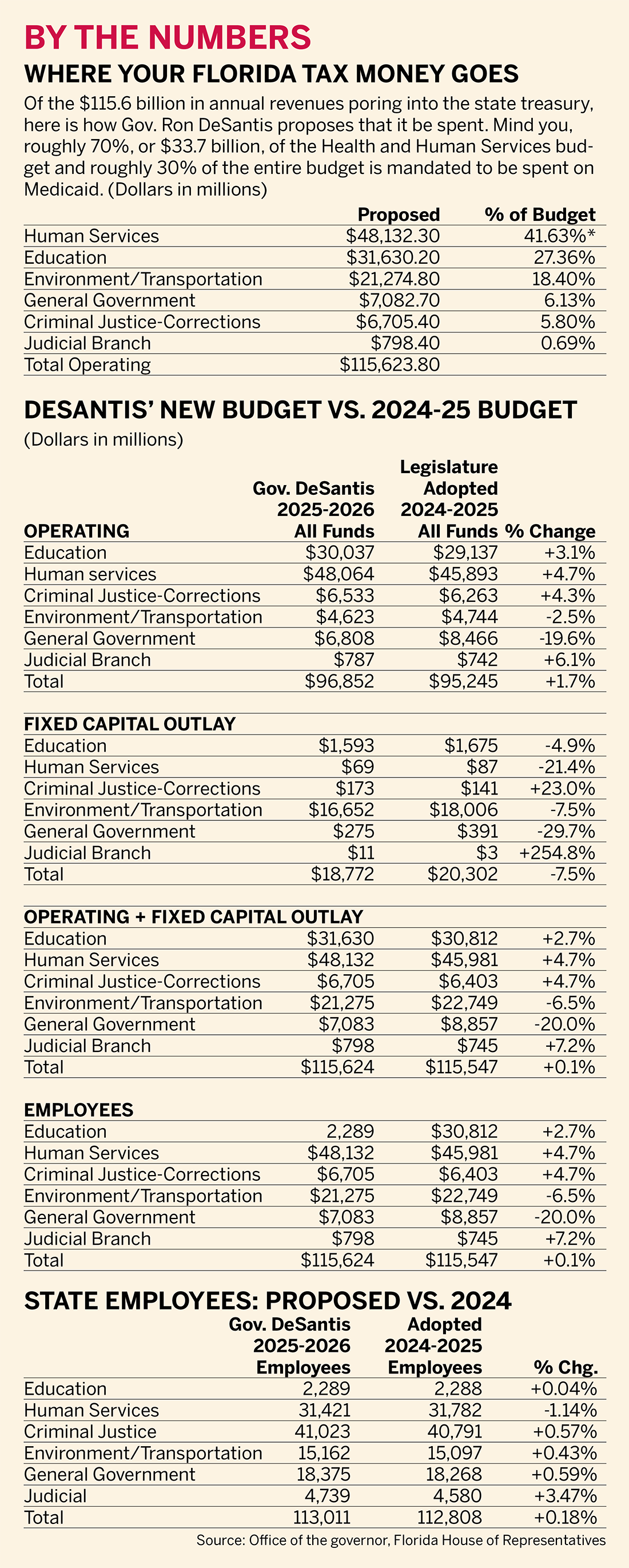- May 21, 2025
-
-
Loading

Loading
OK, there are too many numbers on this page. You can definitely get a case of “MEGO” — My Eyes Glaze Over — just looking at them.
But every now and then, it’s good for all of us to keep tabs on what our governor and legislators are doing with all that money we send them.
All that money: $115 BILLION a year.
That is a huge amount of money.
Comparatively, the Texas state government budgets $321 billion a year; the New York budget is $230 billion; and the Georgia state government budgets $66 billion a year.
Or put another way:
Florida spends $5,024 for each of its 23,014,551 residents. Texas spends $10,294 for each of its 31,183,290 residents. New York spends $11,578 for each of its 19,867,248 residents. And Georgia spends $5,906 for each of its 11,180,878 residents.
It looks like Floridians have a good deal — that is, if you’re one to favor low taxes, limited government and more liberty.
That approach certainly produces convincing benefits. If you read Gov. Ron DeSantis’ proposed 2025-26 budget highlights, he points out how his and the Legislature’s management of state government has resulted in remarkable economic results. To wit:
All of that comes about because of Florida’s overall quality-of-life climate — favorable weather (notwithstanding a few hurricanes); favorable lifestyle amenities (beaches, et al); favorable business climate; and no state income tax.

Those factors combined bring about another essential ingredient to economic growth and prosperity: population growth.
We know, of course, many Floridians want the population growth to stop. And to be sure, if the Legislature became dumb enough to reverse course and adopt the New York state approach of horribly high taxes and regulations, the Florida economic miracle would disappear.
Many of us can remember how bad things were from 2008 through 2010 during the big recession. Population and economic growth stopped. Unemployment soared. It was awful.
And here is one other factor to take into account: Florida’s No. 1 export — tourism.
Longtime Florida economist Hank Fishkind told us years ago that Floridians live on an automatic 20% discount. Tourist-generated sales tax revenues cover roughly 20% of the cost of state and local government in Florida. Be nice to our visitors.
But all that goodness aside, let’s get back to the governor’s proposed budget.
One of the governor’s jobs is to submit to the Legislature how he would like to spend the state’s tax money.
Think about that. If someone handed you $115 billion and told you to divvy it up around the state, how would you possibly prioritize who gets what?
Indeed, it’s illuminating and instructive for every interested Florida taxpayer to see how DeSantis wants to “invest” your money. (“Invest,” of course, is a politician’s way of avoiding the word “spend.”) To his credit, if you’re at all interested in your state government’s handling of your money, it would be worth your time to read the governor’s 28 pages of budget “highlights,” in which he itemizes where he wants much of that $115 billion to go.
For about 30% of the budget, or nearly $34 billion, neither DeSantis nor the Legislature has control. That’s money that must go toward funding Florida’s share of federal Medicaid.
That leaves about $81 million. And then, as you can see in the top table, 41%, or $48 billion, goes toward public education.
Now you’re down to $33 billion to cover the rest of the state’s needs and wants.
It becomes a process of picking winners and losers.
Here is one minor highlight from his proposed budget:
“(I)nvestments in Florida’s deer and wild turkey populations and to design and construct new shooting sports and archery facilities in Liberty and Polk counties.” Really?
Or, how about this one: $50 million for the Sun Trail Network. This is the statewide version of Sarasota’s Legacy Trail. The Legislature approved plans in 2015 to develop free-access trails for bicyclists and pedestrians throughout the entire state.
Here’s the point: You’re encouraged to read the highlights of the governor’s proposed budget. That may trigger you to raise obvious questions: Why are taxpayers funding certain projects and programs? Indeed, many of them are subsidies for a few at the expense of the many.
That is especially true when you look at all of the governor’s proposed tax holidays. While the positive side of these holidays is that they cut taxes, they cut taxes only for special groups.
We’ve argued repeatedly that rather than play that game, cut the state sales tax for everyone.
Altogether, Floridians are fortunate. While we all can question and criticize how the state’s lawmakers spend our tax dollars, DeSantis and the Legislature live up to DeSantis’ title for his budget — “Focus on Fiscal Responsibility” — far better than most states.
But they still can do better.